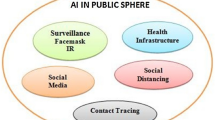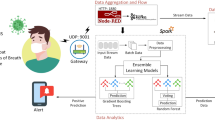Abstract
COVID-19 endemic has made the entire world face an extraordinary challenging situation which has made life in this world a fearsome halt and demanding numerous lives. As it has spread across 212 nations and territories and the infected cases and deaths are increased to 5,212,172 and 334,915 (as of May 22 2020). Still, it is a real hazard to human health. Severe Acute Respiratory Syndrome cause vast negative impacts economy and health populations. Professionals involved in COVID test can commit mistakes when testing for identifying the disease. Evaluating and diagnosing the disease by medical experts are the significant key factor. Technologies like machine learning and data mining helps substantially to increase the accuracy of identifying COVID. Artificial Neural Networks (ANN) has been extensively used for diagnosis. Proposed Single Hidden Layer Feedforward Neural Networks (SLFN)-COVID approach is used to detect COVID-19 for disease detection on creating the social impacts and its used for treatment. The experimental results of the proposed method outperforms well when compared to existing methods which achieves 83% of accuracy, 73% of precision, 68% of Recall, 82% of F1-Score.
Access this chapter
Tax calculation will be finalised at checkout
Purchases are for personal use only
Similar content being viewed by others
References
Mukherjee, A., Ghosh, S., Behere, A., Ghosh, S. K., & Buyya, R. (2021). Internet of health things (IoHT) for personalized health care using integrated edge-fog-cloud network. Journal of Ambient Intelligence and Humanized Computing, 12, 943–959.
Punn, N. S., Sonbhadra, S. K., & Agarwal, S. (2020). COVID-19 epidemic analysis using machine learning and deep learning algorithms. MedRxiv.
Medscape Medical News, The WHO declares public health emergency for novel coronavirus. (2020). https://www.medscape.com/viewarticle/924596
Sampathkumar, A., Murugan, S., Rastogi, R., Mishra, M. K., Malathy, S., & Manikandan, R. (2020). Energy efficient ACPI and JEHDO mechanism for IoT device energy management in healthcare. In Internet of things in smart technologies for sustainable urban development (pp. 131–140).
Khanday, A. M. U. D., Rabani, S. T., Khan, Q. R., Rouf, N., & Din, M. M. U. (2020). Machine learning based approaches for detecting COVID-19 using clinical text data. International Journal of Information Technology, 12(3), 731–739.
Iwendi, C., Bashir, A. K., Peshkar, A., Sujatha, R., Chatterjee, J. M., Pasupuleti, S., & Jo, O. (2020). COVID-19 patient health prediction using boosted random forest algorithm. Frontiers in Public Health, 8, 357.
Tuli, S., Tuli, S., Tuli, R., & Gill, S. S. (2020). Predicting the growth and trend of COVID-19 pandemic using machine learning and cloud computing. Internet of Things, 11, 100222.
Sujath, R., Chatterjee, J. M., & Hassanien, A. E. (2020). A machine learning forecasting model for COVID-19 pandemic in India. Stochastic Environmental Research and Risk Assessment, 34, 959–972.
Jiang, X., Coffee, M., Bari, A., Wang, J., Jiang, X., Huang, J., & Huang, Y. (2020). Towards an artificial intelligence framework for data-driven prediction of coronavirus clinical severity. Computers, Materials & Continua, 63(1), 537–551.
Abdani, S. R., Zulkifley, M. A., & Zulkifley, N. H. (2020). A lightweight deep learning model for covid-19 detection. In 2020 IEEE Symposium on Industrial Electronics & Applications (ISIEA) (pp. 1–5).
He, K., Zhang, X., Ren, S., & Sun, J. (2015). Spatial pyramid pooling in deep convolutional networks for visual recognition. IEEE Transactions on Pattern Analysis and Machine Intelligence, 37(9), 1904–1916.
Abdani, S. R., & Zulkifley, M. A. (2019). Densenet with spatial pyramid pooling for industrial oil palm plantation detection. In 2019 International conference on Mechatronics, Robotics and Systems Engineering (MoRSE) (pp. 134–138).
Hossain, M. S., & Muhammad, G. (2016). Cloud-assisted industrial internet of things (iiot)–Enabled framework for health monitoring. Computer Networks, 101, 192–202.
Stojanović, O., Leugering, J., Pipa, G., Ghozzi, S., & Ullrich, A. (2019). A bayesian monte carlo approach for predicting the spread of infectious diseases. PloS one, 14(12).
Singh, D., Kumar, V., & Kaur, M. (2020). Classification of COVID-19 patients from chest CT images using multi-objective differential evolution–based convolutional neural networks. European Journal of Clinical Microbiology & Infectious Diseases, 39(7), 1379–1389.
Gangavarapu, T., & Patil, N. (2019). A novel filter–wrapper hybrid greedy ensemble approach optimized using the genetic algorithm to reduce the dimensionality of high-dimensional biomedical datasets. Applied Soft Computing, 81, 105538.
Zhou, L., Li, Z., Zhou, J., Li, H., Chen, Y., Huang, Y., & Gao, X. (2020). A rapid, accurate and machine-agnostic segmentation and quantification method for CT-based COVID-19 diagnosis. IEEE Transactions on Medical Imaging, 39(8), 2638–2652.
Arun, S. S., & Iyer, G. N. (2020). On the analysis of COVID19-Novel corona viral disease pandemic spread data using machine learning techniques. In 2020 4th International Conference on Intelligent Computing and Control Systems (ICICCS) (pp. 1222–1227).
Oh, Y., Park, S., & Ye, J. C. (2020). Deep learning covid-19 features on cxr using limited training data sets. IEEE Transactions on Medical Imaging, 39(8), 2688–2700.
Marmarelis, V. Z. (2020). Predictive modeling of Covid-19 data in the US: Adaptive phase-space approach. IEEE Open Journal of Engineering in Medicine and Biology, 1, 207–213.
Barabas, J., Zalman, R., & Kochlán, M. (2020). Automated evaluation of COVID-19 risk factors coupled with real-time, indoor, personal localization data for potential disease identification, prevention and smart quarantining. In 2020 43rd International conference on Telecommunications and Signal Processing (TSP) (pp. 645–648).
Fan, D. P., Zhou, T., Ji, G. P., Zhou, Y., Chen, G., Fu, H., & Shao, L. (2020). Inf-net: Automatic covid-19 lung infection segmentation from ct images. IEEE Transactions on Medical Imaging, 39(8), 2626–2637.
Ye, Y., Hou, S., Fan, Y., Qian, Y., Zhang, Y., Sun, S., & Laparo, K. (2020). α-Satellite: An AI-driven system and benchmark datasets for hierarchical community-level risk assessment to help combat COVID-19. arXiv preprint arXiv:2003.12232.
Gaur, L., Bhatia, U., Jhanjhi, N. Z., Muhammad, G., & Masud, M. (2021). Medical image-based detection of COVID-19 using Deep Convolution Neural Networks. In Multimedia Systems (Vol. 1–10).
Wang, Y., Niu, D., & Ji, L. (2012). Short-term power load forecasting based on IVL-BP neural network technology. Systems Engineering Procedia, 4, 168–174.
You, X., & Cao, X. (2015). Study of liquid lithium coolant interaction based on BP neural network optimized by genetic algorithm. Journal of Fusion Energy, 34(4), 918–924.
Rumelhart, D. E., Hinton, G. E., & Williams, R. J. (1986). Learning representations by back-propagating errors. Nature, 323(6088), 533–536.
Xie, Z., Du, Q., Ren, F., Zhang, X., & Jamiesone, S. (2015). Improving the forecast precision of river stage spatial and temporal distribution using drain pipeline knowledge coupled with BP artificial neural networks: A case study of Panlong River, Kunming, China. Natural Hazards, 77(2), 1081–1102.
Wang, S. T., Chen, D. Y., Hou, P. G., Wang, X. L., Wang, Z. F., & Wei, M. (2015). Determination of the sodium methylparaben content based on spectrum fluorescence spectral technology and GA-BP neural network. Guang pu xue yu guang pu fen xi= Guang pu, 35(6), 1606–1610.
Our World In Data: COVID-19 Dataset; source: https://github.com/owid/covid-19-data/tree/master/public/data/
Situation Reports-WHO; https://www.who.int/emergencies/diseases/novel-coronavirus-2019/situation-reports
Author information
Authors and Affiliations
Corresponding author
Editor information
Editors and Affiliations
Rights and permissions
Copyright information
© 2022 The Author(s), under exclusive license to Springer Nature Switzerland AG
About this chapter
Cite this chapter
Murugan, S., Vijayakumar, K., Sivakumar, V., Manikandan, R., Kumar, A., Saikumar, K. (2022). Impact of Internet of Health Things (IoHT) on COVID-19 Disease Detection and Its Treatment Using Single Hidden Layer Feed Forward Neural Networks (SIFN). In: Anandan, R., Suseendran, G., Chatterjee, P., Jhanjhi, N.Z., Ghosh, U. (eds) How COVID-19 is Accelerating the Digital Revolution. Springer, Cham. https://doi.org/10.1007/978-3-030-98167-9_3
Download citation
DOI: https://doi.org/10.1007/978-3-030-98167-9_3
Published:
Publisher Name: Springer, Cham
Print ISBN: 978-3-030-98166-2
Online ISBN: 978-3-030-98167-9
eBook Packages: Computer ScienceComputer Science (R0)




